|
The Story Of:

Founded
to assist in CSS Alabama
dispute, the CNHS turned
out to do much, much more to save the Confederate Navy.
By John Townley
When
the Abandoned
Shipwreck Act, designed
to
protect sunken historic vessels from
looters, was signed into law in 1988, it seemed to many in the maritime
history
community like it was effectively hot air. Vague wording and lack of
real
provisions for enforcement meant that looters continued to have a field
day
trashing what were often naval gravesites to make a quick buck on the
burgeoning relics market. Things looked bleak, especially for Civil War
vessels
(CW reenacting was booming, relics were in high demand), and even more
for
Confederate Navy vessels because they were mainly the ones on the
bottom,
having lost the war.
Although
few were aware at the time, the ghost of the
Confederate Navy’s most celebrated surface raider, the CSS Alabama,
was about to surface
like some avenging wraith and in just a few short years cast a net of
protection
over all her undefended comrades in the deep. Her wreck had been
discovered off
Cherbourg, France only four years before and there was active
contention over
who owned her remains, France or the U.S., with vocal proponents for
each side
not even agreeing to disagree on the subject. On the American side, an
Alabama
Association was forming in Mobile, Alabama, home of her captain Raphael
Semmes
to counter the similarly-named French association, when Georgia
merchant marine
officer and historian Michael P. Higgins and Tennessee lawyer and
preservationist Roger DeMik approached
Kevin
Foster, then curator of the Confederate Naval Museum (now the Civil War
Naval
Museum) in Columbus, Georgia with the suggestion of forming an
independent
organization to help encourage cooperation on both sides.
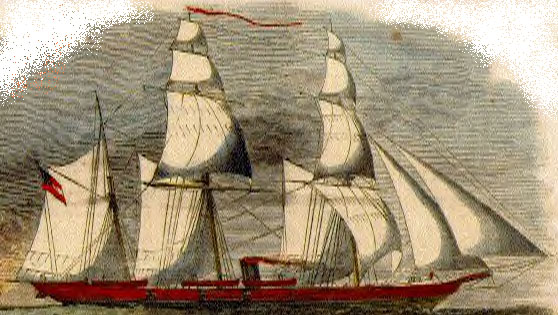 CSS Alabama
was the beginning, and the rest of the Confederate Navy followed quickly
CSS Alabama
was the beginning, and the rest of the Confederate Navy followed quicklyA few
more maritime historians and preservation activists
were corralled, including a star-spangled, who’s-who board
of
advisers
who were wonderfully supportive of the effort, and I was selected to
spearhead
the new organization as president, mainly because I had the time,
personal
resources, and contacts to completely throw into the project. Plus,
just as
important, I was politically neutral and not hampered by working for or
with a
government (either one) or other special interest group. It was called
The
Confederate Naval Historical Society, founded as a not-for-profit
corporation
in Virginia, October 20, 1988, officially
chartered for
the purposes of
promoting Confederate naval history and preserving the remains of the
vessels
of the Confederate Navy.
Although
the disputes over the Alabama had inspired its
creation, and we did have some fruitful talks and visits with the
parties
involved, that project was already taking a turn for the better,
regardless.
The rest of the remains of the Confederate Navy, it turned out, were
not. Our
first emergency was news that the Port of Richmond, under Federal
funding, was
about to widen the channel of the James River at Drewrey’s
Bluff, which would
entail the total destruction of three completely-preserved Confederate
ironclads beneath the mud, the Virginia
II, the Richmond,
and the Fredericksburg,
Confederate Navy Secretary Maury’s “chained
bulldogs”
that had protected Richmond from invasion up until the very end of the
war. A
quick drive to Drewrey’s Bluff revealed actual dredging
marker buoys, awaiting
the beginning of the project only two weeks away. How had Richmond
managed to
sidestep the built-in protection for these ships, which they knew were
there?
It turned out they had evaded the necessary Federal historical impact
survey by
promising to pay for the project themselves up front and collect the
Federal
funds further down the line. Clever ruse, indeed, and the Richmond city
manager
was making lots of political capital ballyhooing the opening up the
port to bigger
vessels and new trade. Calls to state and city preservation authorities
were
met with a shrug, and it seemed nothing could be done. Then it occurred
to one
of us that perhaps the dredgers themselves had been kept in the dark
about this
and wouldn’t appreciate breaking their machinery smashing
into several
two-hundred ton iron objects. A much-welcomed call to their company
cracked the
whole thing open, and another to the newspapers exposed the entire
operation.
It was quickly cancelled, and the city manager was fired. But most
important,
the three best-preserved ironclads of the Civil War still remain
peacefully
intact until funds can eventually be found to recover them.
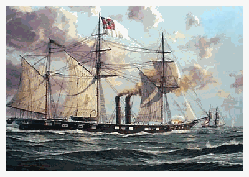
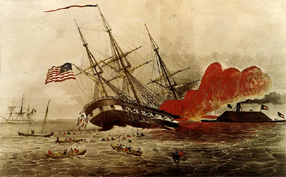
Wrecks of
CSS Florida
and USS Cumberland
were being looted,
resulting in CNHS-generated FBI sting
No
sooner had that fire been put out then another one
surfaced, in the form of relic-dealers’ ads for reproduction
CSN belt buckles
made from melted-down fastenings from the CSS Florida,
in addition to relics from the USS Cumberland,
a war grave, which everyone had assumed were still
peacefully lying next to each other on the bottom at Hampton Roads. Not
so,
apparently. A couple of ambitious watermen were busily raking the
wrecks with
oyster dredges and selling everything they could find. Again, calls to
Virginia
state preservation department and even to the U.S. Naval Criminal
Investigative
Service (NCIS) brought nothing but a series of buck-passings and
assurances of
no support. It was somebody else’s job.
So, in
an evening of despair, our board of directors sat
in my living room wondering just whose job it was, if not the federal
and state
services created for the purpose. It looked hopeless, indeed. Then, the
question arose: who actually owned
this stuff that was being stolen? Well, technically, the government did
– all
Confederate property at the end of the war officially became property
of the
General Accounting Office (GAO). And, who do you call when someone is
robbing
the government? The FBI.
That
sounded a bit too much like television, but I was on
the phone the next morning to the Hampton Roads FBI office with the
tale, and
they had only one question for me: “Is this stuff worth over
$10,000?” You bet.
“Well that’s ten years in prison
and a $10,000 fine” came their reply, and all they needed
were the details. The
details included corresponding with relic dealers and taking photos of
the
stolen artifacts, plus taping phone calls with them naming names,
dates, and
locations of all involved in the operation. It seemed to take them
forever, but
they did a thorough job, and just as the most important items were
about to go
on auction at a major Civil War relics show in Richmond, FBI agents
swooped
down in simultaneous raids on multiple dealers, including the largest
in Virginia, arresting them and
seizing so
many artifacts they had to rent a hotel room to store them in until the
Hampton
Roads Naval Museum
agreed to take charge
of what had been confiscated. In the subsequent trial, two watermen
were
convicted of felonies, and the CNHS became very
unpopular among local watermen and sport divers (well, the greedy ones,
anyway).
More
important, however, was the controversy it stirred up
within government agencies who should have been enforcing the Abandoned
Shipwrecks Act. After the NCIS being scooped by the FBI, the Navy
became far
more interested in historical wrecks, with the help of one of our board
members, William S. Dudley, then senior historian at the U.S. Naval
Historical
Center. It now polices wrecks and prosecutes offenders, all one could
ask for,
and barring future enforcement neglect or new and more clever
perpetrators, the
bulk of the underwater Confederate Navy has been saved. For our
efforts, I was
honored to receive on behalf of the CNHS the first-ever cash reward
($500) from
the Department of the Interior under the provisions of the Abandoned
Shipwreck
Act, for assisting in its enforcement.
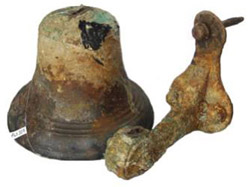
After
a successful court case over fake Alabama
bell, the real thing was found on the wreck itself
After
this intensely dramatic episode, things began to
lighten up a bit, as the Navy took the reins and before long had seized
what
was alleged to be the ship’s bell of the Alabama
from a New Jersey relic dealer, which he was looking to sell for
$100,000. The
question was, was it real? The poor fellow was damned either way
– if it was
real, he was under arrest for theft, if not then it was fraud. Worse,
it turned
out to be an elaborate hoax, which we uncovered through our agents in
England
and wrote up in our newsletter in an interview with the man who had set
it up
as a joke, years before. The
newspapers
ate it up,
and illegal relic sellers were reminded once
again that the
eagle was watching them.
When
there were no ships left to save, we turned to other
matters Confederate and naval, including successfully lobbying Strom
Thurmond’s
office for badly needed seawall repairs to prevent the imminent
destruction of
Fort Fisher, which had protected blockade runners supplying the
Confederacy
through the port of Wilmington, NC. And, throughout, supported by a
large and
enthusiastic paying membership who rallied to the cause, we published a
newsletter that included regular original research articles by noted
naval
historians, stories of major (and minor) vessels, their careers, and
their
final resting places, along with the latest news and inside information
behind
the Confederate naval stories of the day.
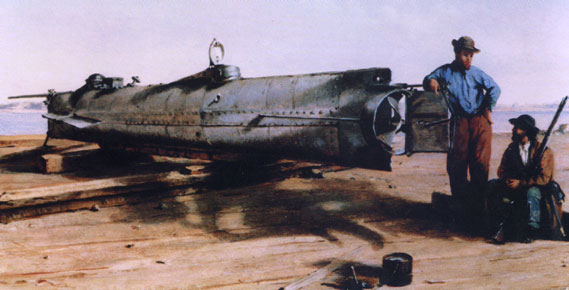 By the time the
submarine CSS Hunley
surfaced in Charleston, the rest of
the CSN was
finally safe
By the time the
submarine CSS Hunley
surfaced in Charleston, the rest of
the CSN was
finally safeBut,
after only seven years of existence, it was becoming
clear that the CNHS had accomplished most of its mission. When the
history-making
Confederate submarine CSS Hunley
was
discovered in Charleston harbor in 1995, there were no attendant relic
hunters
to chase off, only legit archaeologists and historical societies along
with
authorities hovering close by to see that nothing untoward was done.
The CSN,
such as was left of it, was safe and had never had so much interest,
good
press, and revived research. Even the Alabama,
with many a genial
Franco-American handshake, was being carefully explored and its
artifacts
retrieved and carefully restored for museum display, including the real
ship’s bell. There really wasn’t much for us to do
anymore.
So,
when I moved out of my house in Virginia, CNHS VP
Kevin Foster, by then the head of the Federal National Maritime
Initiative,
took the small CNHS library and records to his basement for
safekeeping.
Ironically, there they were destroyed by a flood, suffering the same
fate as
most of the navy they helped preserve. Somehow, seemingly safe on land,
the
organization managed to join its navy next to Davy Jones’
locker, but only
after its job was
done.
In retrospect, the CNHS
remains a shining example of
skilled and dedicated organization and cooperation of the private and
public
sectors, at home and abroad, that is often difficult in the
frequently-contentious climate of historical preservation and
especially
underwater archaeology. Technically, CNHS is actually still alive
– it’s even
listed as an affiliate of the Council of American Maritime Museums
(CAMM)
– but in practical reality it has
joined the ranks of the likes of the Alabama
which inspired it, a well-satisfied wraith with a genuine government
award for
its mission, accomplished.
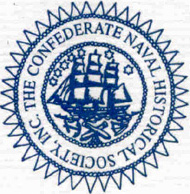
The
CNHS Newsletter:
We are
posting as many
issues of the
CNHS newsletter as we’ve been able to locate – so
far, issues #2-9, plus #11 –
and if anyone out there has #1, #10, or any of the half-dozen from #12
on,
please do send us xeroxes or PDFs of them so we can hopefully make a
complete
collection available for all. Contact us at jwtownley@aol.com
#1
--
#2
-- October '89
-- Alabama
accord
signed, CSS Florida
story,
Ironclad Database,
Maury house danger
#3
-- February '90
-- Mobile
Bay
vessels (by Clive Cussler), CSS Stonewall,
Capt. Thomas J. Lockwood
#4
-- July '90 --
FBI
Seizures
complete, CSS Sumter,
lost ironclad Atlanta,
responsible sport diving
#5
-- October '90
--
Battlefield
Protection Program, Music in the CSN, Confederate Naval Bibliography
#6
-- February '91
-- Alabama
Bell Seized, CSN Missile
Mystery, CSS Tallahassee, Alabama
Commission
#7
-- June '91
-- Alabama
bell awarded to Navy, Ft.
Fisher peril, The Star of the West
#8
-- October '91
--
Liverpool CHQ,
Blockade runner America/Camilla,
plus "The Littlest Blockade Runner"
#9
-- February '92 -- Alabama
treasures displayed at Navy
Museum, John McIntosh Kell, Commodore Tucker
#10
--
#11
-- October '92
-- Navy
wins bell
case, Ft. Fisher snafu, Mobile Bay report reveals looting, NPS helps
|